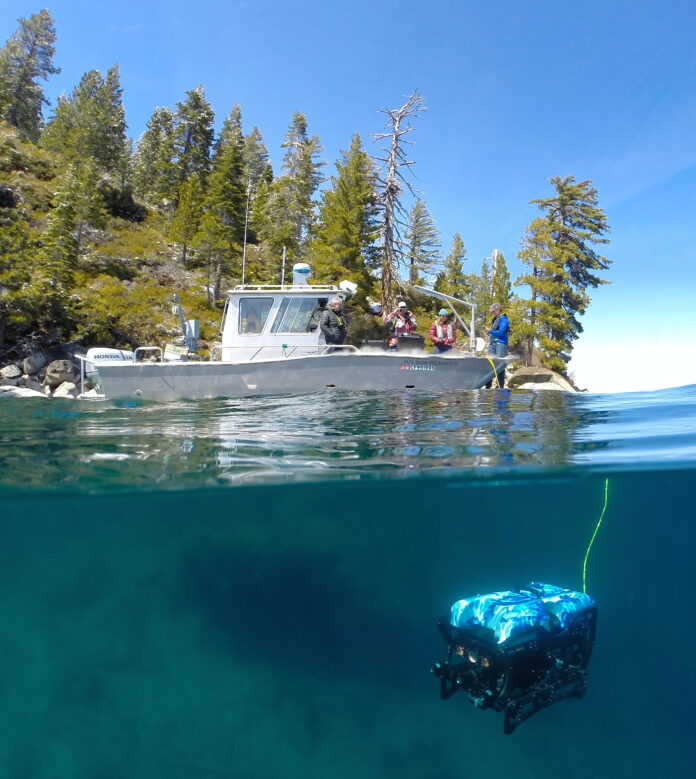The 2022 Tahoe State of the Lake report informs programs to combat environmental destruction and maintain Tahoe as a popular vacation spot
By LEVI GOLDSTEIN — features@theaggie.org
Lake Tahoe is a popular retreat destination throughout the year for outdoorsy Californians, including hikers and boat enthusiasts in the summer and skiers in the winter. But with climate change and global warming leading to the deterioration of the environment, the future of the lake is uncertain. However, students and professors at UC Davis have hope that scientific research may help preserve Tahoe’s beauty.
The UC Davis Tahoe Environmental Research Center (TERC), founded in 1958, conducts research on the status of Lake Tahoe through regular monitoring practices and programs involving the lake’s diverse ecosystem. As part of a mission for education and public outreach, the TERC’s annual State of the Lake Report informs government agencies and community organizations on the best practices for maintaining the lake’s health, according to Director Geoffrey Schladow.
“Every year, we’re building on that long-term record, seeing how trends are evolving, seeing whether the last year is in some way very different than the previous years or the previous trends and trying to explain why it was different [or] why it was the same,” Schladow said. “[The State of the Lake Report] is an opportunity to present these latest research results to give the broader community a sense of what UC Davis and scientists, in general, are doing.”
The Tahoe Regional Planning Agency (TRPA), founded in 1969 through a bi-state contract between California and Nevada, is one of the many organizations that uses data from the TERC’s State of the Lake Report. The TRPA’s Environmental Improvement Program (EIP) seeks to reverse environmental destruction and create sustainable communities, and according to Sustainability Program Manager Devin Middlebrook, scientific studies inform its programs.
“We do have a lot of science that has gone into studying the climate and climate change at Tahoe, and that has told us what impacts on the environment are most likely to occur and how they’re going to occur,” Middlebrook said. “We then use that science to inform policy and programs and implementation of projects. […] This year, we created an updated climate resilience strategy for the region that outlines a 10-year project list for building climate resilience in the Tahoe basin, and that revolves around five focus areas: sustainable recreation and transportation, wildfire forests, watershed biodiversity, infrastructure and communities and science and stewardship.”
The TRPA’s EIP relies on research conducted by its own scientists and by leading organizations such as the TERC. One trend the TERC has measured and reported on in the State of the Lake Report is the declining population of crustaceans in the lake, which is concerning because it may have repercussions for the lake’s food web, according to Schladow. Another recent trend that is of concern to scientists is increasing algae growth.
“We’ve seen almost an explosion in algae, particularly around the shore of the lake,” Schladow said. “It used to be that you would go to the beaches and the sand was golden brown and the water was clear. This year, in many parts of the lake, the water is bright green and dead algae washes up on the lake and starts to rot and decompose. It smells, there are flies […] it defies your memories or your imagination of what [Tahoe is] like. It’s totally unlike most people’s experience.”
The algae bloom directly impacts one of the reasons why it’s essential to keep Lake Tahoe healthy — tourism. Tahoe as a vacation destination is important to the region both culturally and economically, according to Schladow.
“Lake Tahoe is iconic to people in the west, people who have had the fortune to go up there as children with their parents or their grandparents and they have these memories of it,” Schladow said. “It’s regionally extremely important. Something like 50 million people a year go to Tahoe. […] It generates a five-billion-dollar economy. There’s a lot of people in that region who depend on Tahoe being healthy and being perceived as healthy.”
The research being conducted at Lake Tahoe, including at UC Davis’s TERC, is also influential to the scientific community around the world.
“Because of [Lake Tahoe’s] iconic status, a lot of people look to it to see what progress is being made,” Schladow said. “Anything we do to improve its health is looked upon, not just in the U.S. but all around the world. […] Because it’s in the richest state in the nation, there are resources available to study it, and what we learn from having those resources people in other locations build on that. In a way, we’re helping other people maintain their own lakes, their own reservoirs, their own aquatic systems.”
Schladow expressed that the future of Tahoe is uncertain and that scientists are unsure of how extreme the coming changes will be. However, studying Tahoe and monitoring its health to inform communities and guide sustainability programs should help reduce the impact of climate change and keep Tahoe an iconic destination.
“The science has shown us that climate change is here and the impacts of climate change will be more severe into the future,” Middlebrook said. “We want to ensure that Lake Tahoe and the beauty that it holds can be here for future generations to enjoy and the communities that call this place home or the visitors that love coming to Tahoe can continue to have that experience.”
Written by: Levi Goldstein — features@theaggie.org



